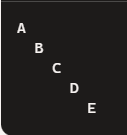Pattern programs are a fundamental part of learning any programming language. They help in understanding loops, conditionals, and character manipulation. In this post, we will explore how to design straight-line alphabet patterns using loops in C. This guide is tailored for both beginners and seasoned programmers who want to strengthen their skills and add a touch of creativity to their coding practice.
"Programming is the art of algorithm design and the craft of debugging errant code." - Ellen Ullman
Getting Started with Straight-Line Alphabet Patterns
Straight-line alphabet patterns in C are relatively simple to design but can be quite visually appealing. These patterns primarily involve nested loops and the use of ASCII values to print characters in a straight line. Let's dive into a few examples to understand how to create these patterns.
Flowchart: Process of Designing a Straight-Line Alphabet Pattern
Example 1: Vertical Line of Alphabets
Let's start with a basic example of printing alphabets in a vertical line.
Diagram: Vertical Line Pattern
Explanation:
The outer loop (i from 0 to 4) controls the number of characters.
The character ch starts from 'A' and increments with each iteration of the loop.
Example 2: Horizontal Line of Alphabets
Now, let's create a pattern where alphabets are printed in a horizontal line.
Diagram: Horizontal Line Pattern
Explanation:
The outer loop (i from 0 to 4) controls the number of characters.
The character ch starts from 'A' and increments with each iteration of the loop.
A space (" ") is printed after each character to create the horizontal line.
Complex Patterns Using Straight Lines
Example 3: Diagonal Line of Alphabets
A diagonal pattern can add a bit more complexity to your straight-line patterns.
Diagram: Diagonal Line Pattern
Explanation:
The outer loop (i from 0 to 4) controls the rows.
The inner loop (j from 0 to 4) controls the columns.
The condition (if (i == j)) ensures that characters are printed diagonally..
Real-World Application: Custom Label Printing
Pattern programs are not just theoretical exercises; they have real-world applications as well. For example, you might use a straight-line pattern to create custom labels for an organization system.
Diagram: Custom Label Pattern
Explanation:
The function printLabel takes a string (label) and its length as input.
The loop prints each character of the string with a space in between.
"Any fool can write code that a computer can understand. Good programmers write code that humans can understand." - Martin Fowler
Conclusion
Designing straight-line alphabet patterns in C is a great way to practice using loops and character manipulation. From simple vertical and horizontal lines to more complex diagonal lines, these patterns can help you improve your coding skills and add a creative touch to your programs. By experimenting with different designs, you can discover new ways to express yourself through code.
Tags & Keywords
Tags:
C programming, Alphabet patterns, Pattern programs, Coding examples, C language tutorials, Programming basics, Coding for beginners, Creative coding, Code snippets, Programming challenges.
Keywords:
Straight-line alphabet patterns in C, C programming pattern programs, C code examples, Alphabet patterns with loops, Vertical and horizontal alphabet patterns, Diagonal alphabet patterns in C, C programming tutorials, Coding practice with C, Learning C programming, Creative patterns in C language.
Topic-Related FAQs
What are straight-line alphabet patterns in C?
Straight-line alphabet patterns in C are programs that print alphabets in simple lines—either vertical, horizontal, or diagonal—using nested loops and ASCII values.
How do straight-line alphabet patterns help in learning C programming?
These patterns help in understanding the basics of loops, conditionals, and character manipulation, which are fundamental concepts in C programming.
Can beginners learn from creating straight-line alphabet patterns in C?
Yes, beginners can greatly benefit from creating these patterns as they offer hands-on practice with essential programming concepts in a fun and engaging way.
What are some common straight-line alphabet patterns in C?
Common patterns include vertical lines, horizontal lines, and diagonal lines. These patterns can be modified and expanded to create more complex designs.
Are there any real-world applications of straight-line alphabet patterns in C?
Yes, they can be used in real-world applications such as generating custom labels, creating educational tools, or even designing simple text-based graphics.
How can I create a vertical line pattern using alphabets in C?
A vertical line pattern can be created using a single loop to print characters in a column. An example code snippet is provided in the blog post.
What is the role of ASCII values in creating straight-line alphabet patterns?
ASCII values help in manipulating and printing characters in a specific sequence. By understanding ASCII values, you can create various patterns using characters.
Can I experiment with different shapes and designs using straight-line alphabet patterns?
Absolutely! These patterns offer a platform for creativity, allowing you to experiment with different shapes, designs, and even mix characters with symbols to create unique patterns.
What are some advanced straight-line patterns I can try?
Advanced patterns include creating mirrored designs, combining multiple shapes, and using conditional statements for more complex patterns. The diagonal pattern example in the blog post is a good starting point.
Where can I find more examples of straight-line alphabet patterns in C?
You can find more examples in coding books, online tutorials, and programming communities. Additionally, experimenting with your own ideas and sharing them with others can lead to discovering new patterns.
For full ‘Pattern Programs in C’ resources click this link.
…till next post, bye-bye & take care.







No comments:
Post a Comment